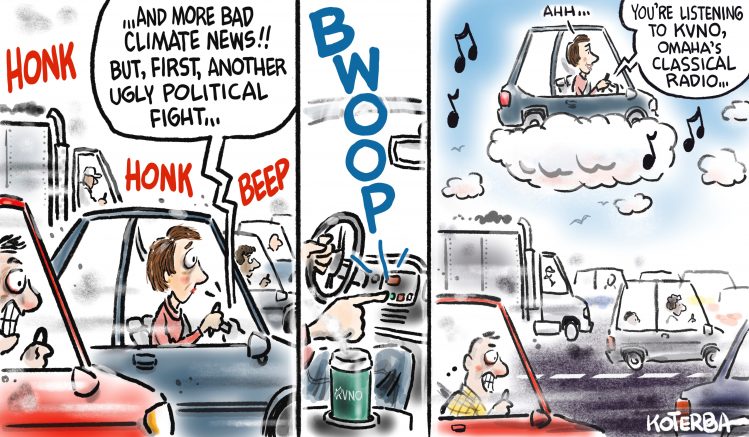
Drawing a Line to Chopin
June 15th, 2022
When KVNO station manager and host of Midday Classics, Sherry Kennedy Brownrigg, asked if I’d be willing to draw a cartoon celebrating the music we play, I instantly knew the direction I’d go. Occasionally, ideas are like that. They practically write (or draw!) themselves. Besides, the topic is one in which I’m very passionate.
With all the hustle and bustle of our day-to-day activities, to say nothing of some of the anxiety-inducing news as of late, the world can certainly be a stressful place. One of the many things I love—not only as a listener of KVNO, but as the fill-in host for Otis Twelve—is that the station provides a respite from all the hubbub (side note: isn’t “hubbub” kind of fun to say?). A positive and uplifting place to get away from it all, if even for a few minutes. I don’t know about you, but when I listen to classical music in my car or at home (or while filling in at the studio) I find myself letting out a deep sigh of relief—that is, when I’m not humming along or air conducting.
And while not all of us are driving around while listening to KVNO, many are—commuting to and from work, taking the kids to school, etc. And that can certainly be exhausting. Especially when traffic is bad (is there ever good traffic?). So what better way to symbolize a stressful moment—in an image and in a few words—than showing someone all stressed out in heavy traffic? And let’s be honest. Even commuting from the bedroom to the home office has its own sort of stress (How does my hair look? Where’s my cat or dog? I mean, the others on Zoom count on seeing little Finn every morning, don’t they?). But I digress.
Back to the cartoon. The modern world can also be a really cool place. During the pandemic I switched from drawing with pen and ink on paper to creating on an iPad—which has been life-changing. Not only can I achieve details I couldn’t when drawing the old way, my iPad also captures each and every stroke of the pen. When I’m drawing I’m often so focused and in the zone I don’t really pay attention to exactly every scribble and scratch. But having a video replay allows me to go back and watch my process, line by line. It’s kind of an existential/meta moment, a surreal experience.
Anyway, this piece? It took a grand total of…timpani roll, please…4,091 strokes of the pen.
As the video moves along you’ll see in the second frame where the driver switches the radio to KVNO (Another side note: I loved putting in the detail of a KVNO travel mug, coffee steam coming out). By the third frame, of course, the driver is not only calmer but uplifted, seemingly floating above the traffic.
Cue the sigh of relief: Ahhh…
Something else I do when listening to classical music, besides relaxing: I experience these little flights of fancy. In my mind, perhaps I make a quick trip to a magical land. Or I ponder the quirky and the interesting. Case in point: the music for this creative-process video is Frédéric Chopin’s “Raindrop” prelude, Op. 28, No. 15. As I was putting this video together with the music, watching my 4,091 strokes of the pen going by, I got to wondering. How many notes make up the “Raindrop” Prelude? Or any of Chopin’s preludes, for that matter?
Last month, when renowned violinist, Lara St. John, performed the world premiere of Martin Kennedy’s “Violin Concerto in D” with the Omaha Symphony (broadest live on KVNO, by the way), Maestro Ankush Kumar Bahl said that the piece consisted of over 10,000 individual notes just for the violin. 10,000 notes Lara St. John had to memorize. Which got me to thinking about how many notes are in other pieces of music. Like Chopin’s preludes, for example. After a fairly-extensive Google search turned up nothing, I reached out to KVNO host and music director, Emily McIvor. In less than a day, Emily got back to me saying she’d pulled out her copy of the “Raindrop” prelude and actually counted each note in the Chopin piece (counting chords as one note considering they all sound together as one). Her answer? 1032!
It’s cool putting a number to the Chopin prelude. And as amazing as it is to know how many pen strokes make up one of my cartoons, there’s something equally beautiful in a mystery. I mean, when we gaze into the night sky, on average, how many stars do we see? Several hundred? A few thousand? We can take a guess—and probably you can easily Google that answer—but I also kind of like not knowing.
Yes, information is good. And a little news goes a long way. But sometimes, I don’t need to know every single thing going on in the world. When I’m stuck in traffic, waiting for the light to turn green, what better way to find an uplifting moment than to listen to some of the greatest music ever written. Regardless of how many notes make up a particular piece, ultimately, it’s the way the piece makes us feel that counts.

